ACCT2002 Corporate Accounting Assignment: Financial Analysis Report
VerifiedAdded on 2022/09/07
|8
|1418
|17
Report
AI Summary
This report presents a detailed analysis of a corporate accounting assignment, focusing on the financial performance of Commonwealth Bank of Australia (CBA). The assignment includes a comprehensive ratio analysis covering operational management, investment management, financing strategy, and dividend policies. Key financial ratios such as operating profit margin, interest coverage ratio, total asset turnover ratio, debt-to-equity ratio, and dividend payout ratio are calculated and interpreted for the years 2018 and 2019. The report also addresses the business strategy of CBA, encompassing customer service, business banking, technology, and operational excellence. Furthermore, the assignment delves into consolidation processes, including journal entries, worksheet completion, and the preparation of consolidated financial statements. The analysis covers adjustments for plant and machinery valuation, depreciation, and pre-acquisition entries, demonstrating the student's understanding of consolidation principles and financial statement preparation. The assignment provides a practical application of accounting concepts and financial analysis techniques.
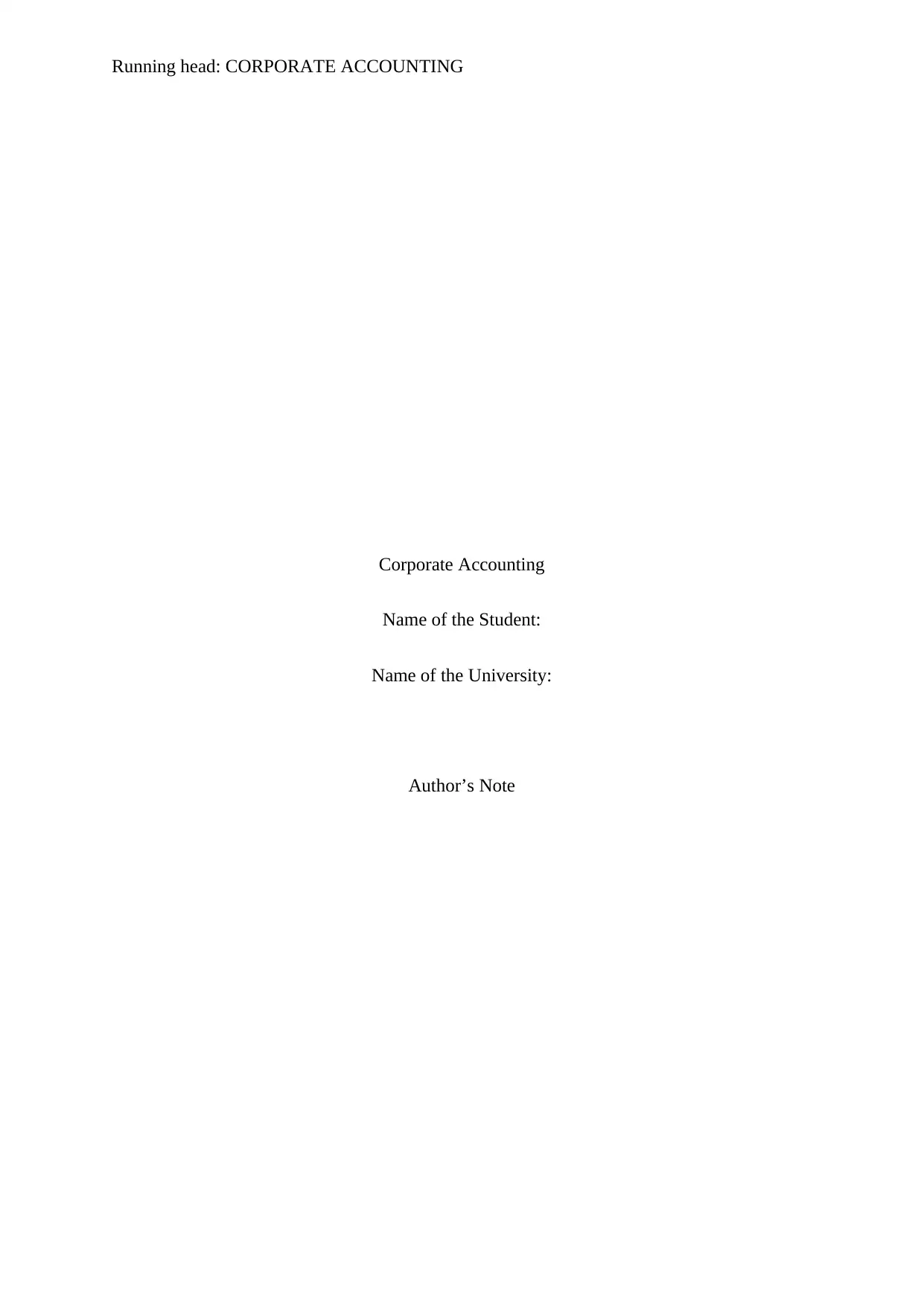
Running head: CORPORATE ACCOUNTING
Corporate Accounting
Name of the Student:
Name of the University:
Author’s Note
Corporate Accounting
Name of the Student:
Name of the University:
Author’s Note
Paraphrase This Document
Need a fresh take? Get an instant paraphrase of this document with our AI Paraphraser
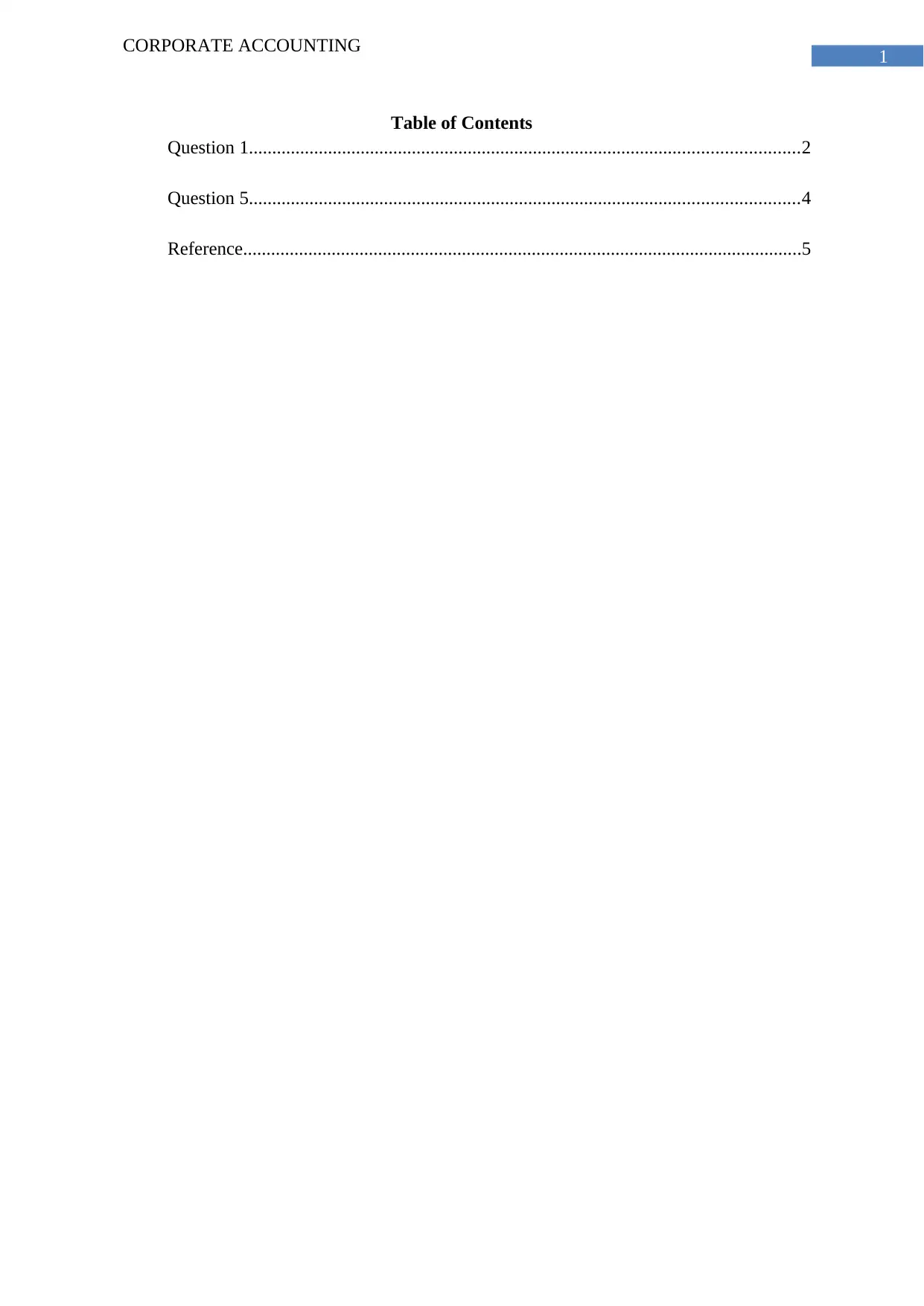
1
CORPORATE ACCOUNTING
Table of Contents
Question 1......................................................................................................................2
Question 5......................................................................................................................4
Reference........................................................................................................................5
CORPORATE ACCOUNTING
Table of Contents
Question 1......................................................................................................................2
Question 5......................................................................................................................4
Reference........................................................................................................................5

2
CORPORATE ACCOUNTING
Question 1
The company which is being considered is Common wealth Bank of Australia which
is engaged in providing banking services to the customers (Commbank.com.au. 2020). The
performance of the business is to be ascertained and the same would be done with the help of
key financial ratios which would cover four specific areas. The computation of key ratios is
presented in the table below:
Ratio Analysis for CommonWealth Bank of Australia
Particulars 2019 2018
$m $m
Operation Management
Operation Profit 11,763 13,022
Net Revenue 24,337 25,130
Interest Expenses 3391 3952
Operating Profit margin 0.483 0.518
Interest coverage ratio 0.139 0.157
Investment Management
Total Assets 976,502 975,165
Net Revenue 24,337 25,130
Receivables 8093 9222
Total asset turnover ratio 0.024923 0.02577
Receivables turnover ratio 3.007167 2.725005
Financing Strategy
Debt 163,990 172,294
Equity 69,594 67,306
Total Asset 976,502 975,165
Debt to Equity Ratio 2.356381 2.559861
Debt to Total Asset Ratio 0.167936 0.176682
Dividend Policy
Dividend 6853 5366
Total Revenue 24,337 25,130
Dividend Payout Ratio 0.281588 0.21353
EPS 473. 7 518. 8
Operational Management
The operational management is closely related to managing the day to day operations
of the business and the same is conducted to make profits. The ratios which are computed in
CORPORATE ACCOUNTING
Question 1
The company which is being considered is Common wealth Bank of Australia which
is engaged in providing banking services to the customers (Commbank.com.au. 2020). The
performance of the business is to be ascertained and the same would be done with the help of
key financial ratios which would cover four specific areas. The computation of key ratios is
presented in the table below:
Ratio Analysis for CommonWealth Bank of Australia
Particulars 2019 2018
$m $m
Operation Management
Operation Profit 11,763 13,022
Net Revenue 24,337 25,130
Interest Expenses 3391 3952
Operating Profit margin 0.483 0.518
Interest coverage ratio 0.139 0.157
Investment Management
Total Assets 976,502 975,165
Net Revenue 24,337 25,130
Receivables 8093 9222
Total asset turnover ratio 0.024923 0.02577
Receivables turnover ratio 3.007167 2.725005
Financing Strategy
Debt 163,990 172,294
Equity 69,594 67,306
Total Asset 976,502 975,165
Debt to Equity Ratio 2.356381 2.559861
Debt to Total Asset Ratio 0.167936 0.176682
Dividend Policy
Dividend 6853 5366
Total Revenue 24,337 25,130
Dividend Payout Ratio 0.281588 0.21353
EPS 473. 7 518. 8
Operational Management
The operational management is closely related to managing the day to day operations
of the business and the same is conducted to make profits. The ratios which are computed in
⊘ This is a preview!⊘
Do you want full access?
Subscribe today to unlock all pages.

Trusted by 1+ million students worldwide
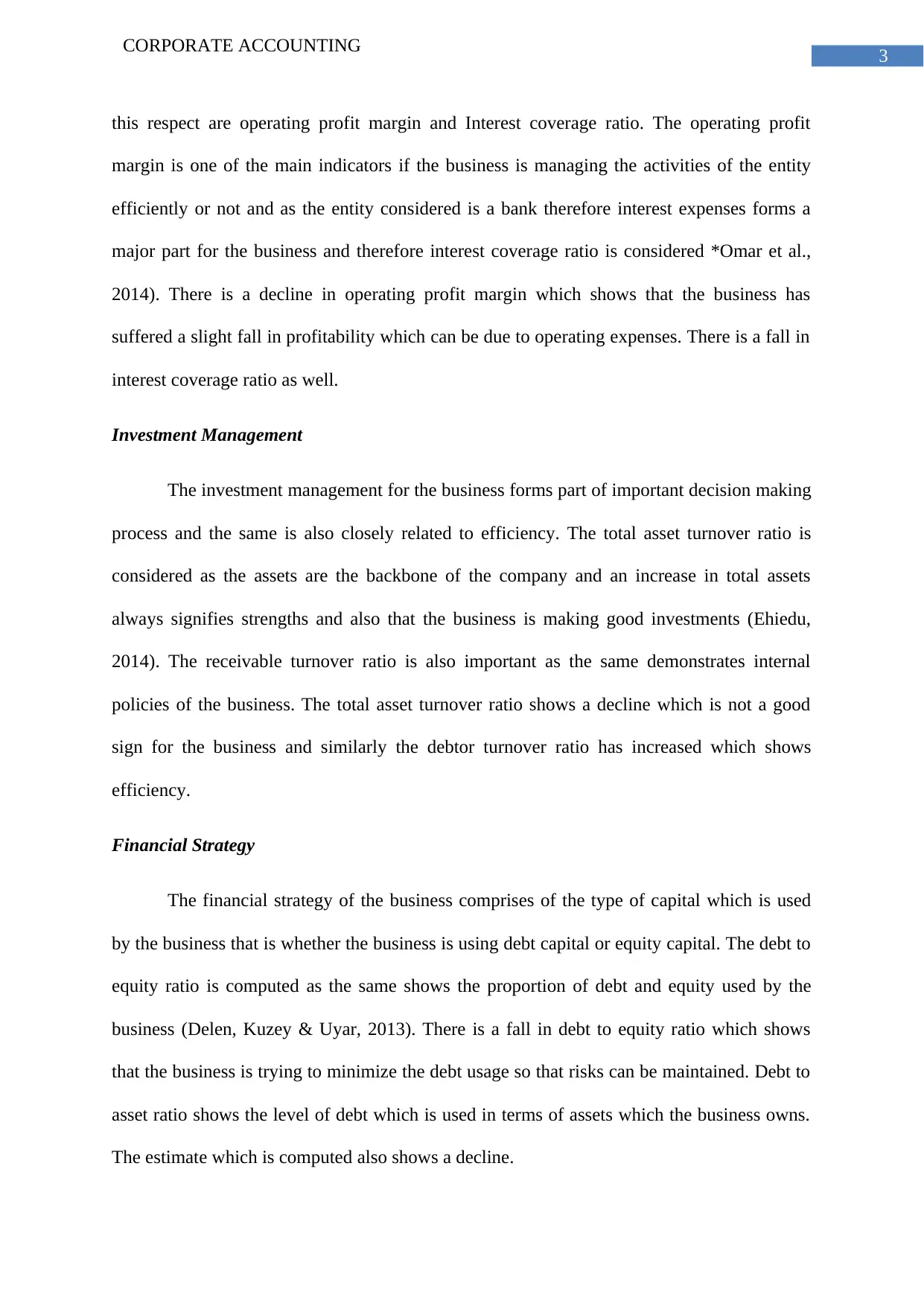
3
CORPORATE ACCOUNTING
this respect are operating profit margin and Interest coverage ratio. The operating profit
margin is one of the main indicators if the business is managing the activities of the entity
efficiently or not and as the entity considered is a bank therefore interest expenses forms a
major part for the business and therefore interest coverage ratio is considered *Omar et al.,
2014). There is a decline in operating profit margin which shows that the business has
suffered a slight fall in profitability which can be due to operating expenses. There is a fall in
interest coverage ratio as well.
Investment Management
The investment management for the business forms part of important decision making
process and the same is also closely related to efficiency. The total asset turnover ratio is
considered as the assets are the backbone of the company and an increase in total assets
always signifies strengths and also that the business is making good investments (Ehiedu,
2014). The receivable turnover ratio is also important as the same demonstrates internal
policies of the business. The total asset turnover ratio shows a decline which is not a good
sign for the business and similarly the debtor turnover ratio has increased which shows
efficiency.
Financial Strategy
The financial strategy of the business comprises of the type of capital which is used
by the business that is whether the business is using debt capital or equity capital. The debt to
equity ratio is computed as the same shows the proportion of debt and equity used by the
business (Delen, Kuzey & Uyar, 2013). There is a fall in debt to equity ratio which shows
that the business is trying to minimize the debt usage so that risks can be maintained. Debt to
asset ratio shows the level of debt which is used in terms of assets which the business owns.
The estimate which is computed also shows a decline.
CORPORATE ACCOUNTING
this respect are operating profit margin and Interest coverage ratio. The operating profit
margin is one of the main indicators if the business is managing the activities of the entity
efficiently or not and as the entity considered is a bank therefore interest expenses forms a
major part for the business and therefore interest coverage ratio is considered *Omar et al.,
2014). There is a decline in operating profit margin which shows that the business has
suffered a slight fall in profitability which can be due to operating expenses. There is a fall in
interest coverage ratio as well.
Investment Management
The investment management for the business forms part of important decision making
process and the same is also closely related to efficiency. The total asset turnover ratio is
considered as the assets are the backbone of the company and an increase in total assets
always signifies strengths and also that the business is making good investments (Ehiedu,
2014). The receivable turnover ratio is also important as the same demonstrates internal
policies of the business. The total asset turnover ratio shows a decline which is not a good
sign for the business and similarly the debtor turnover ratio has increased which shows
efficiency.
Financial Strategy
The financial strategy of the business comprises of the type of capital which is used
by the business that is whether the business is using debt capital or equity capital. The debt to
equity ratio is computed as the same shows the proportion of debt and equity used by the
business (Delen, Kuzey & Uyar, 2013). There is a fall in debt to equity ratio which shows
that the business is trying to minimize the debt usage so that risks can be maintained. Debt to
asset ratio shows the level of debt which is used in terms of assets which the business owns.
The estimate which is computed also shows a decline.
Paraphrase This Document
Need a fresh take? Get an instant paraphrase of this document with our AI Paraphraser

4
CORPORATE ACCOUNTING
Dividend Policies
The dividend policies of the business show that the management of CBA considers
the interest of the investors fairly. There is an increase in the dividend payout ratios which is
a positive sign for the investors but at the same time there is a decline in the EPS of the
business. The ratios are considered as they are pivotal and are considered by every investor
for taking investment decisions for the business.
Question 5
The business strategy of Commonwealth Bank of Australia can be regarded as four
dimensional as the strategy focuses on customer service, business banking, technology and
operational excellence. The financial policies of the company are also formulated in such a
manner so that the business strategies of the company are well supported and more
improvements can be brought about in the operational process of the business. The company
follows responsible investing policies which ensure that business banking operations are kept
as transparent as possible and integrity of the operations is maintained. The company also
considers the stakeholders engagements and economic and global trade to important part of
the operations and emphasize to make improvements to the same on constant basis.
CORPORATE ACCOUNTING
Dividend Policies
The dividend policies of the business show that the management of CBA considers
the interest of the investors fairly. There is an increase in the dividend payout ratios which is
a positive sign for the investors but at the same time there is a decline in the EPS of the
business. The ratios are considered as they are pivotal and are considered by every investor
for taking investment decisions for the business.
Question 5
The business strategy of Commonwealth Bank of Australia can be regarded as four
dimensional as the strategy focuses on customer service, business banking, technology and
operational excellence. The financial policies of the company are also formulated in such a
manner so that the business strategies of the company are well supported and more
improvements can be brought about in the operational process of the business. The company
follows responsible investing policies which ensure that business banking operations are kept
as transparent as possible and integrity of the operations is maintained. The company also
considers the stakeholders engagements and economic and global trade to important part of
the operations and emphasize to make improvements to the same on constant basis.
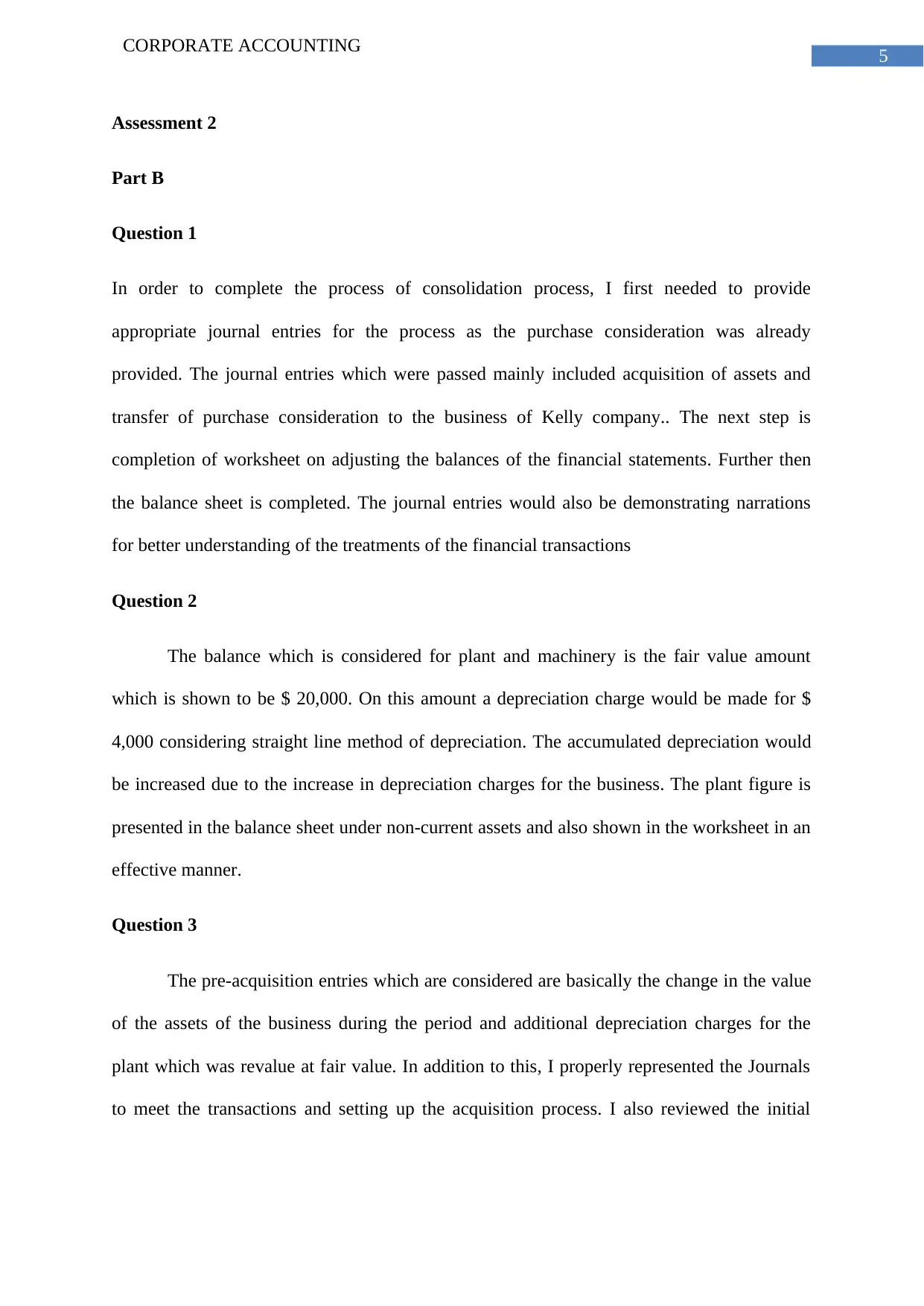
5
CORPORATE ACCOUNTING
Assessment 2
Part B
Question 1
In order to complete the process of consolidation process, I first needed to provide
appropriate journal entries for the process as the purchase consideration was already
provided. The journal entries which were passed mainly included acquisition of assets and
transfer of purchase consideration to the business of Kelly company.. The next step is
completion of worksheet on adjusting the balances of the financial statements. Further then
the balance sheet is completed. The journal entries would also be demonstrating narrations
for better understanding of the treatments of the financial transactions
Question 2
The balance which is considered for plant and machinery is the fair value amount
which is shown to be $ 20,000. On this amount a depreciation charge would be made for $
4,000 considering straight line method of depreciation. The accumulated depreciation would
be increased due to the increase in depreciation charges for the business. The plant figure is
presented in the balance sheet under non-current assets and also shown in the worksheet in an
effective manner.
Question 3
The pre-acquisition entries which are considered are basically the change in the value
of the assets of the business during the period and additional depreciation charges for the
plant which was revalue at fair value. In addition to this, I properly represented the Journals
to meet the transactions and setting up the acquisition process. I also reviewed the initial
CORPORATE ACCOUNTING
Assessment 2
Part B
Question 1
In order to complete the process of consolidation process, I first needed to provide
appropriate journal entries for the process as the purchase consideration was already
provided. The journal entries which were passed mainly included acquisition of assets and
transfer of purchase consideration to the business of Kelly company.. The next step is
completion of worksheet on adjusting the balances of the financial statements. Further then
the balance sheet is completed. The journal entries would also be demonstrating narrations
for better understanding of the treatments of the financial transactions
Question 2
The balance which is considered for plant and machinery is the fair value amount
which is shown to be $ 20,000. On this amount a depreciation charge would be made for $
4,000 considering straight line method of depreciation. The accumulated depreciation would
be increased due to the increase in depreciation charges for the business. The plant figure is
presented in the balance sheet under non-current assets and also shown in the worksheet in an
effective manner.
Question 3
The pre-acquisition entries which are considered are basically the change in the value
of the assets of the business during the period and additional depreciation charges for the
plant which was revalue at fair value. In addition to this, I properly represented the Journals
to meet the transactions and setting up the acquisition process. I also reviewed the initial
⊘ This is a preview!⊘
Do you want full access?
Subscribe today to unlock all pages.

Trusted by 1+ million students worldwide
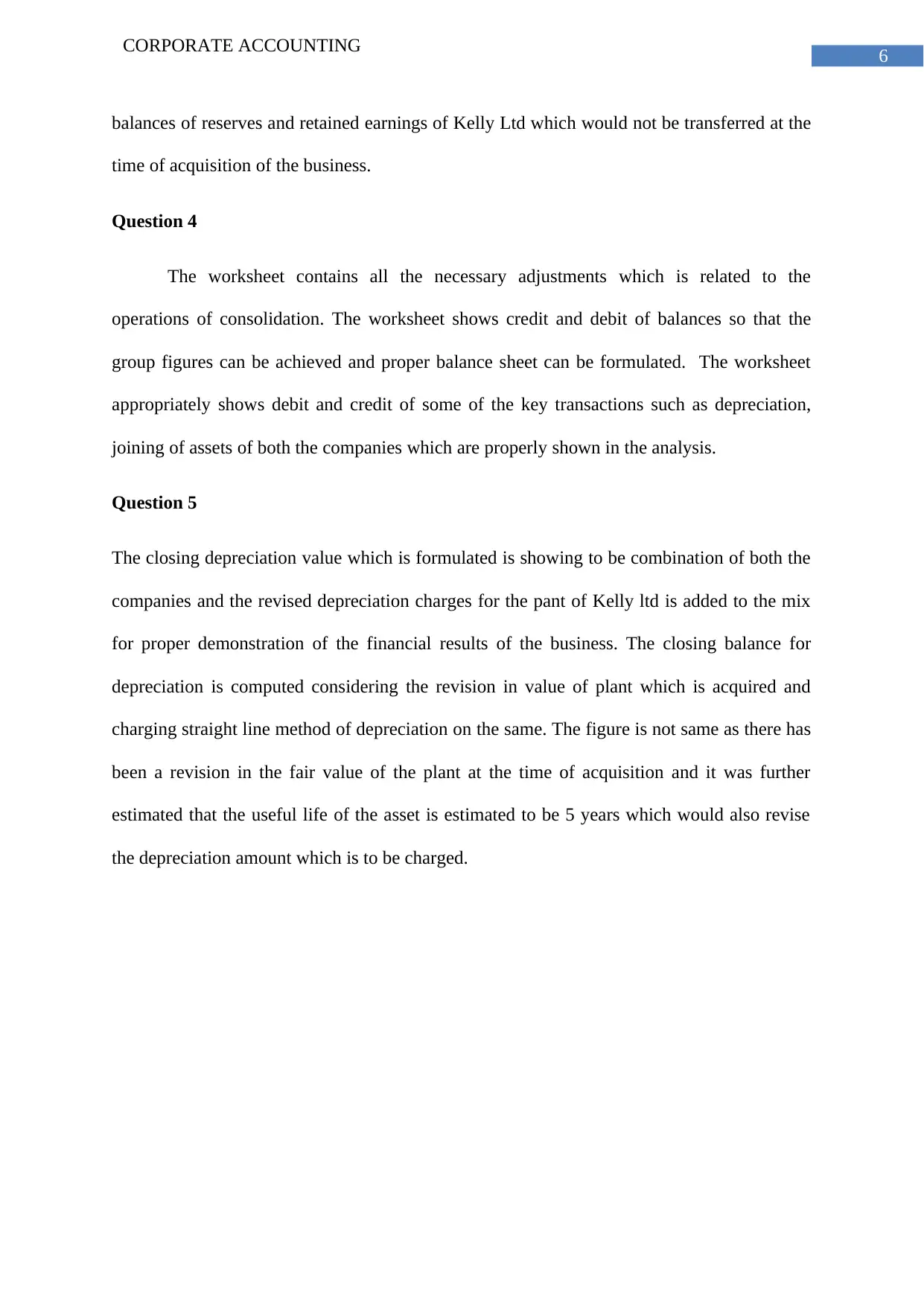
6
CORPORATE ACCOUNTING
balances of reserves and retained earnings of Kelly Ltd which would not be transferred at the
time of acquisition of the business.
Question 4
The worksheet contains all the necessary adjustments which is related to the
operations of consolidation. The worksheet shows credit and debit of balances so that the
group figures can be achieved and proper balance sheet can be formulated. The worksheet
appropriately shows debit and credit of some of the key transactions such as depreciation,
joining of assets of both the companies which are properly shown in the analysis.
Question 5
The closing depreciation value which is formulated is showing to be combination of both the
companies and the revised depreciation charges for the pant of Kelly ltd is added to the mix
for proper demonstration of the financial results of the business. The closing balance for
depreciation is computed considering the revision in value of plant which is acquired and
charging straight line method of depreciation on the same. The figure is not same as there has
been a revision in the fair value of the plant at the time of acquisition and it was further
estimated that the useful life of the asset is estimated to be 5 years which would also revise
the depreciation amount which is to be charged.
CORPORATE ACCOUNTING
balances of reserves and retained earnings of Kelly Ltd which would not be transferred at the
time of acquisition of the business.
Question 4
The worksheet contains all the necessary adjustments which is related to the
operations of consolidation. The worksheet shows credit and debit of balances so that the
group figures can be achieved and proper balance sheet can be formulated. The worksheet
appropriately shows debit and credit of some of the key transactions such as depreciation,
joining of assets of both the companies which are properly shown in the analysis.
Question 5
The closing depreciation value which is formulated is showing to be combination of both the
companies and the revised depreciation charges for the pant of Kelly ltd is added to the mix
for proper demonstration of the financial results of the business. The closing balance for
depreciation is computed considering the revision in value of plant which is acquired and
charging straight line method of depreciation on the same. The figure is not same as there has
been a revision in the fair value of the plant at the time of acquisition and it was further
estimated that the useful life of the asset is estimated to be 5 years which would also revise
the depreciation amount which is to be charged.
Paraphrase This Document
Need a fresh take? Get an instant paraphrase of this document with our AI Paraphraser

7
CORPORATE ACCOUNTING
Reference
Commbank.com.au. (2020). Retrieved 3 April 2020, from
https://www.commbank.com.au/content/dam/commbank/about-us/shareholders/pdfs/
annual-reports/CBA-2019-Annual-Report.pdf
Delen, D., Kuzey, C., & Uyar, A. (2013). Measuring firm performance using financial ratios:
A decision tree approach. Expert Systems with Applications, 40(10), 3970-3983.
Ehiedu, V. C. (2014). The impact of liquidity on profitability of some selected companies:
The financial statement analysis (FSA) approach. Research Journal of Finance and
Accounting, 5(5), 81-90.
Omar, N., Koya, R. K., Sanusi, Z. M., & Shafie, N. A. (2014). Financial statement fraud: A
case examination using Beneish Model and ratio analysis. International Journal of
Trade, Economics and Finance, 5(2), 184.
CORPORATE ACCOUNTING
Reference
Commbank.com.au. (2020). Retrieved 3 April 2020, from
https://www.commbank.com.au/content/dam/commbank/about-us/shareholders/pdfs/
annual-reports/CBA-2019-Annual-Report.pdf
Delen, D., Kuzey, C., & Uyar, A. (2013). Measuring firm performance using financial ratios:
A decision tree approach. Expert Systems with Applications, 40(10), 3970-3983.
Ehiedu, V. C. (2014). The impact of liquidity on profitability of some selected companies:
The financial statement analysis (FSA) approach. Research Journal of Finance and
Accounting, 5(5), 81-90.
Omar, N., Koya, R. K., Sanusi, Z. M., & Shafie, N. A. (2014). Financial statement fraud: A
case examination using Beneish Model and ratio analysis. International Journal of
Trade, Economics and Finance, 5(2), 184.
1 out of 8
Related Documents
Your All-in-One AI-Powered Toolkit for Academic Success.
+13062052269
info@desklib.com
Available 24*7 on WhatsApp / Email
![[object Object]](/_next/static/media/star-bottom.7253800d.svg)
Unlock your academic potential
Copyright © 2020–2025 A2Z Services. All Rights Reserved. Developed and managed by ZUCOL.





